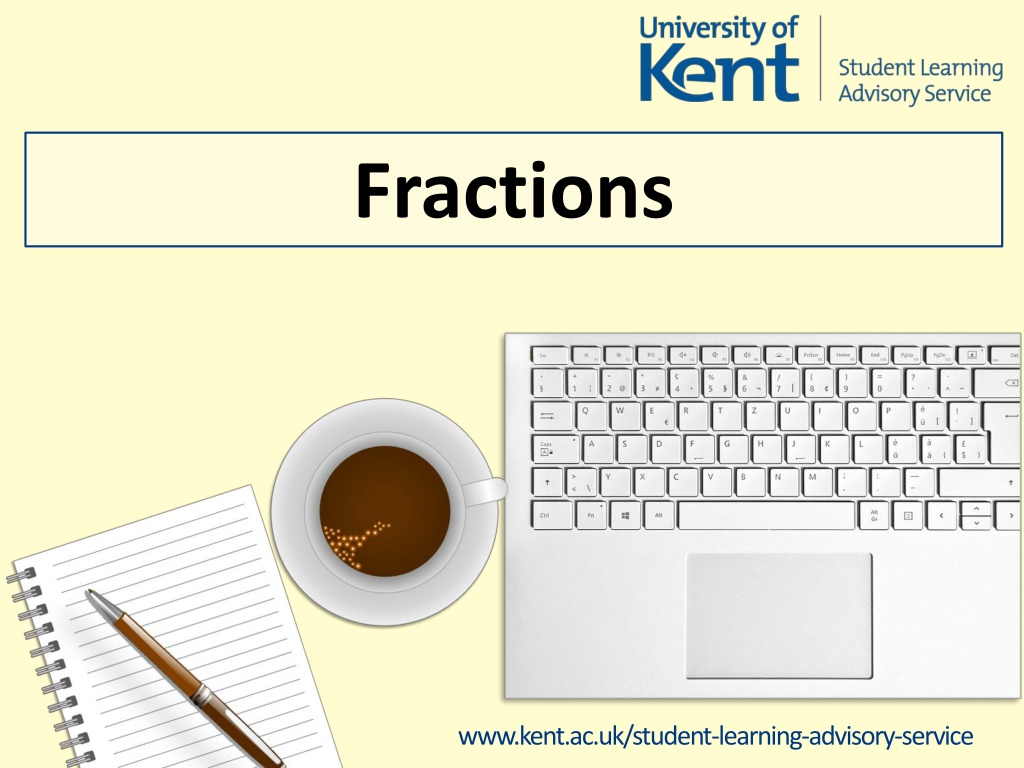Understanding Fractions: Basic Concepts and Operations
This comprehensive guide covers the fundamentals of fractions, including simplest forms, improper fractions, mixed numbers, and operations like addition and subtraction. Learn how to express fractions in their simplest form, convert improper fractions to mixed numbers, and perform arithmetic operations with fractions. The resource also touches on ordering operations and provides examples for better understanding.
Download Presentation

Please find below an Image/Link to download the presentation.
The content on the website is provided AS IS for your information and personal use only. It may not be sold, licensed, or shared on other websites without obtaining consent from the author. Download presentation by click this link. If you encounter any issues during the download, it is possible that the publisher has removed the file from their server.
E N D
Presentation Transcript
Fractions www.kent.ac.uk/student-learning-advisory-service
Fractions Fractions Introduction Basic mathematics of fractions All students
Fractions Fractions Basic mathematics of fractions: Simplest forms Improper fractions and mixed numbers Addition and subtraction Multiplication and division Powers and roots Ordering operations (BODMAS)
Simplest forms Simplest forms A fraction is expressed in its simplest form by cancelling any factors common to the numerator and the denominator: 3). Answer is 3). Answer is 1). Identify factors 1). Identify factors 3 1 3 5 3 = 1 3 5 3 = 1 5 15 = 2). Cancel common factors 2). Cancel common factors
Simplest forms Simplest forms Express the following in their simplest form: ?).12 ?).26 ?).24 55 121 16 39 64 ?). Answers: ?).3 ?).2 ?).3 5 4 3 8 ?). 11
Improper fractions Improper fractions mixed numbers mixed numbers Improper fractions are where the numerator is equal to, or greater than, the denominator: Numerator Numerator greater than greater than denominator denominator Numerator Numerator equal to equal to denominator denominator 5 3 ??11 4 ??5 5 Improper fractions can be converted to mixed numbers and vice versa: 11 11 4 = 2, remainder 3 Divide numerator Divide numerator by denominator by denominator 4 = 2, remainder 3 11 4 = 23 4
Improper fractions Improper fractions mixed numbers mixed numbers Convert the following: ?). 35 ?). 57 ?).17 ?).24 8 11 5 21 Answers: ?).29 ?).62 ?).32 ?).11 8 11 5 7
Addition and subtraction Addition and subtraction To add and subtract fractions, each fraction must be rewritten to have the same denominator typically, the lowest common denominator: 3). Add/subtract 3). Add/subtract numerators numerators 2). Rewrite for new 2). Rewrite for new common denominator common denominator 3 4+3 8 1 6 8+3 8 4 8 = 6 + 3 4 =5 2 = 8 8 1). Identify lowest 1). Identify lowest common denominator common denominator 4). Answer is 4). Answer is
Addition and subtraction Addition and subtraction Solve the following: ?).2 3 ?).1 2 2 3+3 5+ 20 5 Answers: ?).11 ?).13 20 30
Multiplication Multiplication Multiply all the numerators, and multiply all the denominators to give the answer: 1). Multiply numerators 1). Multiply numerators 3). Answer is 3). Answer is 3 4 3 3 3 4 5 = 9 5 = 20 2). Multiply denominators 2). Multiply denominators
Division Division To divide, invert the fraction after the divide symbol and multiply: 3). Simplify 3). Simplify 1). Invert 1). Invert 2 2 3 8 5 6 = 3 8 6 2). Multiply 2). Multiply 18 40 = 2 2 9 5 = 20 4). Answer is 4). Answer is
Multiplication and division Multiplication and division Solve the following: 16 4 7 5 2 ?).1 2 2 5 3 ?). 3 4 Answers: ?).21 ?).15 40 16
Powers Powers Expressed thus, apply the power to the numerator and the denominator: Answer is Answer is 3 23 33 = 2 3 2 2 2 3 3 3 = 8 = 27 Expressed thus, apply the powers separately: 23 32 = 2 2 2 3 3 8 9 = Answer is Answer is
Roots Roots Expressed thus, apply the root to the numerator and the denominator: Simplify Simplify Answer is Answer is 2 2 216 232 50 = 216 25 = 225 =4 5 2 2 Expressed thus, apply the roots separately: 216 327 = 4 3 = 11 Simplify Simplify 3 Answer is Answer is
Powers and roots Powers and roots Solve the following: 3 24 33 ?).22 1 4 218 32 ?). 53 ?). ?). Answers: 1 4 c).3 ?).2 ?). 64 ?). 125 4 27
Ordering operations Ordering operations The order of calculations is: Brackets, pOwers, Division and Multiplication, Addition and Subtraction. 2). 2). pOwers pOwers 1). Brackets 1). Brackets 1 2+1 4 5 2 4 9 3 25 = 4 40 5). Answer is 5). Answer is 3). Div. & Mult. 3). Div. & Mult. 4). Add. & Sub. 4). Add. & Sub.
Ordering operations Ordering operations Solve the following: 2 11 4 5 3 5 5 6+1 ?). 9 6 Answer: ?).10 27
To book a maths/stats appointment To book a maths/stats appointment www.kent.ac.uk/student-learning-advisory-service




























